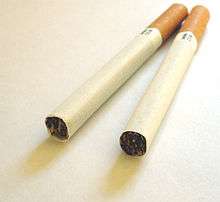Lexington (cigarette)
|
An old Dutch pack of Lexington cigarettes. | |
| Product type | Cigarette |
|---|---|
| Owner | Landewyck Tobacco, British American Tobacco (South Africa only) |
| Produced by | Landewyck Tobacco, British American Tobacco (South Africa only) |
| Country | Luxembourg |
| Introduced | 1950 |
| Markets | See Markets |
| Tagline | "For after action satisfaction, smoke Lexington.", "Lexington, that's the one." |
Lexington is a Luxembourgish brand of cigarettes, currently owned and manufactured by "Landewyck Tobacco".[1] In South Africa, it is sold by BAT South Africa, a subsidiary of British American Tobacco.[2]
History
Lexington was launched in 1950 and became one of the most popular brands of the 1950s, with one billion cigarettes being sold every year since 1955.[3] The cigarettes became a popular brand in the Netherlands and South Africa, but failed on the German market.[4]
Various advertising jingles were made from the 1960s until the 1980s for the South African radio,[5][6] as well as advertising posters in Dutch and South African English and Afrikaans.[7][8] A hand-drawn dog known as Lexi was also created in the 1960s to act as an advertiser for the cigarette brand.[9]
Some of the most popular slogans used to promote the brand were "For after action satisfaction, smoke Lexington." and "Lexington, that's the one."
Controversy
The Lexington-affaire
In 1962, the Dutch Consumentenbond released an article in their own newspaper called the "Consumentengids", comparing the 14 most popular cigarette brands in the Netherlands at the time based on their tar and nicotine levels. The test was done on a special smoking machine that mimics a person who smokes. The test concluded that there was little difference in the amount of nicotine in the cigarettes. The brands Three Castles, Peter Stuyvesant, Chief Whip, and Alaska had the least amount of nicotine in their smoke. The highest amount of nicotine was measured in the Lexington cigarette smoke with 0,88 mg. The differences in tar were much more prominent however. The Roxy cigarette had the least amount of tar with 30,5 mg and passed the test. The brands Hunter and Lexington had twice the amount of tar in their smoke with 75,0 and 63,9 mg respectively and were the brands who failed to pass the test. The findings were posted in the March 1962 edition of the "Consumentengids".
The publication was released at the time when there was a lot of concern about the possible hazards that smoking had for the health. Since the 1950s, research was done about the health risks of smoking and in March of 1962, 5 days after the release of the article, a report was released by the Royal College of Physicians titled "Smoking and health", linking smoking to various kinds of diseases such as lung cancer and heart attacks.[10] The Dutch press paid a lot of attention to the report, as well as the one released of the Consumentenbond. Due to all the exposure from the newspapers, the article reached a lot more people than the usual 35.000 people who were subbed to the "Consumentengids".
The reaction was massive. Many people switched over to the brands that passed the test such as Roxy, others started smoking cigars because it was a safer alternative, and some lessened their smoking habit or even quit smoking altogether.
The article saw people switching en masse to the Roxy brand. The Koninklijke Theodorus Niemeyer BV company used the publication as publicity to advertise their brand as "low tar" and "low nicotine" with the slogan "Roxy – Nu beter dan ooit!".
Not everyone was happy with this test. Abraham Jan Block, which was the importer of the Lexington brand to the Netherlands, was furious. Lexington was the market leader at the time, with nearly 25% of all cigarettes sold in the Netherlands being Lexington cigarettes. Landewyck Tobacco was the producer of the brand.
Most tobacco companies at the time (such as British American Tobacco refused to acknowledge the report, saying it was not factually based and tried to focus as little attention to their brands as possible. Abraham Jan Block however, decided to confront the Consumentenbod by claiming that the results were inaccurate and launched his own tests in London, New York City and Zürich with different results, one showing that the amount of tar was as low as 12,1 mg, compared to the 63,9 mg in the Consumentenbond report. With these results, Blok started a new advertising campaign to "cleanse" Lexington from the dirty image it had acquired.
Blok paid every major Dutch newspaper at the time (117 in total) and cost 250,000 Guilders to post a big advertisement, claiming that the amount of tar in the Lexington cigarettes is much lower than what was reported in the "Consumentengids" report. Blok received many positive messages because of this, including a letter from a fan. This was part of the big campaign offensive, which included the spreading of folders, the many appearances of Lexington advertisements and the Lexington advertisement films shown in the cinemas which showed cool stuntmen and rough cowboys.
The Consumentenbod reacted following the massive advertisement campaign from Blok. Bartholomeus Buitendijk (one of the two original founders of the Consumentenbond) reacted on the radio about the accusations of Blok about the test. Abraham Blok said that it wasn't an exaggeration, due to the fact that the manufacturer of Lexington lost millions after the publication of the article.
On the 25th of May 1962, the Consumentenbond received a summons in which Blok sued them. The primary demand was that the Consumentenbond would have to release an extra edition of the "Consumentengids" with a rectification of the test within one week.
On the 6th of June 1962, the court case was held. J.A. Stoop, the lawyer of Blok, attacked the "irresponsible" and "hasty" publication of the results of the "faulty" cigarettes test of the Consumentenbond and compared it to the results from the other 3 tests done in London, New York and Zürich. From these results it was shown that a different length of cigarette, puff duration, puff frequency and puff volume were used and that the results of tar- and nicotine were different for that reason. The defence, done by lawyer J.A. Nagtegaal, tried to justify the test in every way possible by calling various experts to his defence; Bertram who led the research, a statistician (who abruptly debunked his own research) and a doctor.
The court case went on for multiple days, with the final judgement coming on the 22nd of June 1962. The judgement concluded that the results would be "measurable" which was incorrect. There was no standard way of testing, and the Consumentenbond should have realised it before publishing the article. The judge (which was an avid subscriber of the Consumentenbond, had not smoked for years and hoped that he wouldn't be cut as a subscriber of the paper) said that Lexington was right but didn't agree with all the demands made by Blok. The Consumentenbond was forbidden to repeat the publication and had to pay the process costs (395 Dutch Guilders) of Blok, but did not get a rectification, something that Blok demanded.
In July of 1962, the members of the Consumentenbond and Blok reached a compromise; Blok dropped all the demands for financial compensation, and the Consumentenbond published a rectification in their "Consumentengids", admitting their wrongdoing.
The whole '""Lextington-affaire" was published widely in the press. Before the judge reached his final judgement, there was a lot of criticism of the way the Consumentenbond handled the situation. Especially Elsevier and several trade magazines lashed out at the company, calling the test "shameful and harmful" and the Consumentenbond "meddlesome" and "left-leaning".
The aftermath of the Lexington affaire had big and surprising consequences. The Consumentenbond was accused of being inaccurate and 'dilettantist', but had gained them a lot of publicity as well. The work of the Consumentenbond was published in many newspapers and people started to realise the importance of the company. There was also praised because of such a small company, who bravely fought against a producer of a big and popular brand of cigarettes. The company gained 25.000 new members signed up, with 250.000 members who were part of the Consumentenbond in 1969.
For Blok and Lexington however, things weren't so good. Even though Blok had won the court case, the constant connection between the Consumentenbond test and his brand, as well as the ever-increasing fear of smoking and health hazards and the Dutch cigarette market, saw Lexington's market share crumble. After 2 years, the market share went from nearly 25% to a mere 7%, and within a few years the brand went from one of the most popular brands to a second-tier brand. Despite all of this, is Lexington is still manufactured in the Netherlands until this day. Abraham Blok didn't stay in the Netherlands, he accepted his defeat and moved to Switzerland. The dog "Lexi", which was once used to promote the brand, got terminated after it was decided that he didn't fit into Lexington's market strategy anymore.[9][11][12][13][14][15]
Sponsorships
Formula 1
In the 1975 Formula One season and 1976 Formula One season, Lexington sponsored a private-entry Tyrrell Racing team to compete with Jody Scheckter at the 1975 and 1976 South African Grand Prix. The car used and driven was the Tyrrell 007.[16][17][18][19][20][21]
Markets
Lexington is or was sold in the following countries: Luxembourg, Netherlands, Germany, Greece, Zambia and South Africa.[22][23][24]
See also
References
- ↑ S.A., LANDEWYCK TOBACCO. "Landewyck: cigarettes". Hvl.lu. Retrieved 9 January 2018.
- ↑ "British American Tobacco South Africa - Our brands". Batsa.co.za. Retrieved 9 January 2018.
- ↑ S.A., LANDEWYCK TOBACCO. "Landewyck: History - Sales". Hvl.lu. Retrieved 9 January 2018.
- ↑ "ZIGARETTEN: Für die Katz". 8 May 1978. Retrieved 9 January 2018 – via Spiegel Online.
- ↑ SRPS AUDIO ARCHIVE JOHANNESBURG (24 April 2017). "LEXINGTON CIGARETTES". YouTube. Retrieved 9 January 2018.
- ↑ Ulric Algar (18 January 2012). "Better than a Lexington". YouTube. Retrieved 9 January 2018.
- ↑ "south african memories". Pinterest. Retrieved 9 January 2018.
- ↑ "1960'S LEXINGTON CIGARETTES ADVERT IN AFRIKAANS - bidorbuy.co.za". bidorbuy.co.za. Retrieved 9 January 2018.
- 1 2 ,, , , , , , , , ,. "De Lexington-affaire - Andere Tijden". Andere Tijden. Retrieved 9 January 2018.
- ↑ "Smoking and health (1962)". Rcplondon.ac.uk. 10 September 2015. Retrieved 9 January 2018.
- ↑ "... kwam Lexington als slechtste sigaret uit de bus". Trouw. Retrieved 9 January 2018.
- ↑ "ANDERE TIJDEN - Teleblik". Teleblik.nl. Retrieved 9 January 2018.
- ↑ "Nieuwe Leidsche Courant - 19 april 1962 - pagina 19". Historische Kranten, Erfgoed Leiden en Omstreken. Retrieved 9 January 2018.
- ↑ "De Lexington-affaire en de doorbraak van de consumentenbond (1962)". Isgeschiedenis.nl. 21 June 2017. Retrieved 9 January 2018.
- ↑ "Geschiedenis van 1962 - Het jaar 1962". Aandachtvoorgeschiedenis.nl. Retrieved 9 January 2018.
- ↑ "Lexington Racing - ChicaneF1.com". www.chicanef1.com.
- ↑ "Lexington Racing". 12 June 2017.
- ↑ "F1 - Prywatne zespoły". Pinterest.
- ↑ "Tyrrell 007 / 1 F1 - ex- Lexington Racing , Ian Scheckter , Jody Scheckter Elf Team Tyrrell - South African Drivers Championship 1975 - South African F1 Grand Prix , Kyalami , 1975 & 1976 - Heidelberg Transport Museum , 1998 - SA00085".
- ↑ "Lexington Racing". www.laberezina.com.
- ↑ Papercraft (9 September 2016). "F1 Paper Model - Tyrrell 007 Ford Lexington Racing Ian Scheckte AFS01 Paper Car Free Download".
- ↑ "BrandLexington - Cigarettes Pedia". Cigarettespedia.com. Retrieved 9 January 2018.
- ↑ "Lexington". Zigsam.at. Retrieved 9 January 2018.
- ↑ "Brands". www.cigarety.by.

